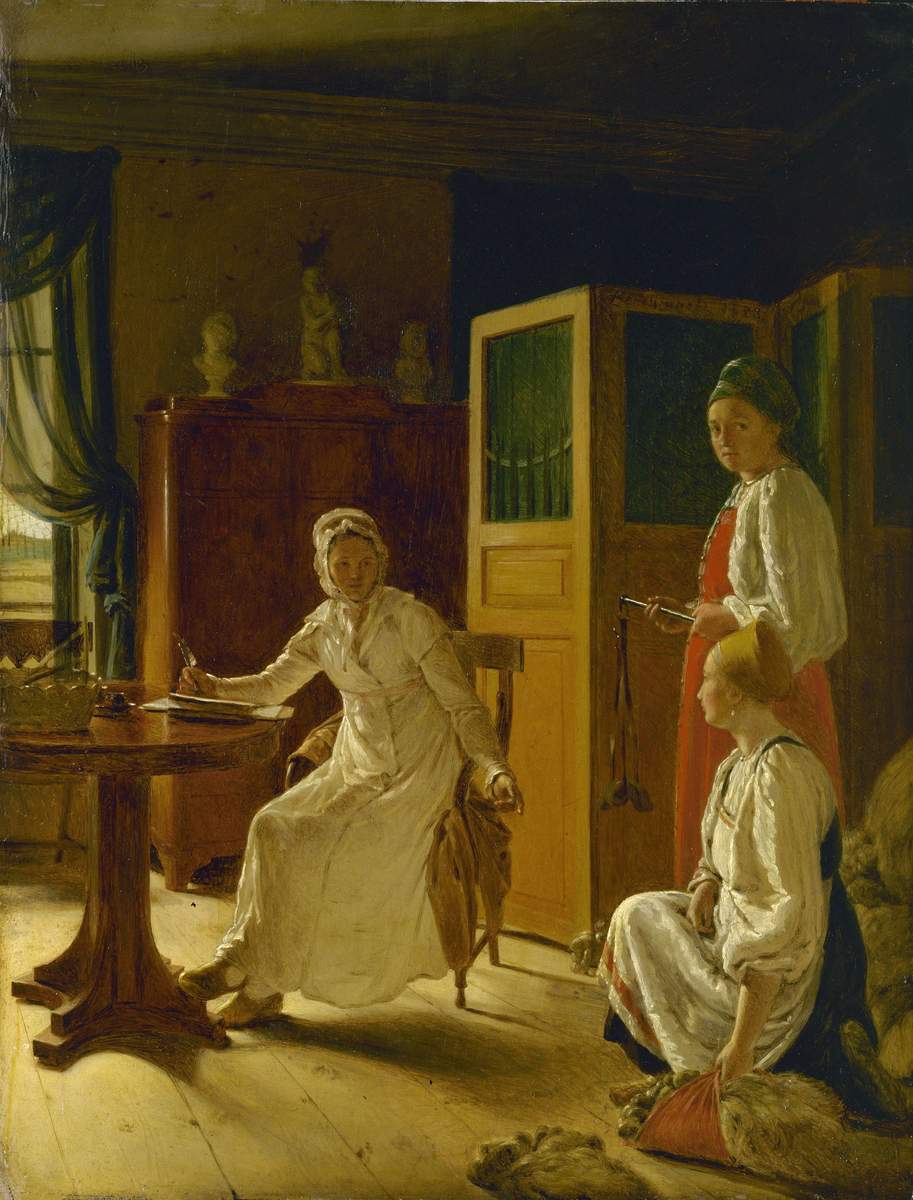


В картине изображена часть кабинета помещичьего дома с обычной, скромной обстановкой. Через узенькую кромку открытого окна в комнату проникает свет раннего утра. За столом сидит молодая хозяйка в домашнем платье, она дает наказ статным, красивым крестьянкам. Одна из них, став на колено, держит в руке завернутый в красную материю тюк шерсти, другая, прервав разговор обратила внимательный взгляд на зрителя. Художник в образах крестьянок передал их спокойное достоинство – обе девушки в картине не менее значительны, чем молодая помещица. От всей сцены веет мирным покоем и уютом неспешной, размеренной жизни “дворянского гнезда”. Картина Венецианова написана в 1823 году, почти одновременно с “сельскими главами” Онегина. Не являясь в прямом смысле иллюстрацией, “Утро помещицы” своей поэтической атмосферой вызывает прямые ассоциации с бытом и укладом жизни Лариных. По давней традиции считалось, что на картине изображена жена художника Марфа Афанасьевна в комнате дома в Сафонкове.
Живописец, жанрист, портретист.
Академик Императорской Академии художеств (1811). Родился в Москве в купеческой семье. В 1802 переехал в Петербург. С 1807 по 1819 состоял на государственной службе - служил чиновником в Почтовом, а затем Лесном департаментах. Живописью стал заниматься поздно, самостоятельно. Брал уроки у В. Л. Боровиковского, копировал картины в Эрмитаже. Творческую деятельность начал как портретист. В 1807 предпринял издание сатирического журнала, который был запрещен правительством. В 1812-1813 участвовал в создании большой серии карикатур на события войны с Наполеоном. Сделал много рисунков на бытовые темы. С 1819 - в отставке, полностью посвятил себя живописи. Жил в своем имении Сафонково Тверской губернии. Создал школу, в которую принимал крепостных и детей из бедных семейств. Автор ряда записок об искусстве и о методах преподавания. С 1820-х тема труда и быта крестьян стала главной в его творчестве, он придал крестьянской тематике значение самостоятельного жанра живописи.

This picture depicts a landowner’s wife giving peasant women flax for spinning in winter, suggesting that it was painted in either late autumn or early winter. On 15 March 1824, Alexei Venetsianov presented the painting to Empress Elizabeth Alexeyevna, wife of Tsar Alexander I (1801–1825), for which he was awarded a diamond signet ring. The artist’s own title for the work was Landowner’s Wife Giving Flax to Peasant Women. Later, in the literature, it became known as Morning of a Landowner’s Wife or Landowner's Wife Engaged in Housekeeping. The painting is traditionally considered to depict the artist’s wife Martha in a room in their house in Safonkovo in Tver Province. A. N. Savinov believes that the image of the landowner’s wife was inspired by M. M. Filosofova. The picture is one of the most important in the oeuvre of Alexei Venetsianov. It is virtually the artist’s only work in which he depicts the nobility coming into contact with the world of the peasantry. Soviet art historians condemned the “incorrect" and idyllic relationship between the landowner's wife and her serfs, complaining at the artist’s failure to show the “trials and horrors of the peasant class.” Venetsianov depicts an everyday scene, which in his interpretation acquires a profound significance. It seems to be something more important than a typical image of the distribution of flax. Flooded with light, the atmosphere of the room in the manorial house is calm and quiet. The figures of the two peasant women are graceful and dignified. Wearing a housecoat and a cap, the landowner’s wife sits at a table, immersed in the shadows. The sunlight only falls on the silhouette of her figure, suggesting that the real heroines of this work are the two peasant women.
Founding father of Russian peasant genre painting. Painter, portraitist, etcher, lithographer. Son of a Moscow merchant, educated at private boarding school, worked as a draughtsman. Moved to St Petersburg (1802) and worked as a land surveyor for the crown properties and forestry departments. Studied painting independently, copied works in the Imperial Hermitage and drew pastel portraits. Academician (1811). Resigned from the civil service, moved to the country and painted genre scenes from life (early 1820s). Exhibited at the Imperial Academy of Arts and the Society for the Encouragement of Artists. Had many students, who formed the Venetsianov school in Russian art. Killed in a road accident at the Milyukov estate.



